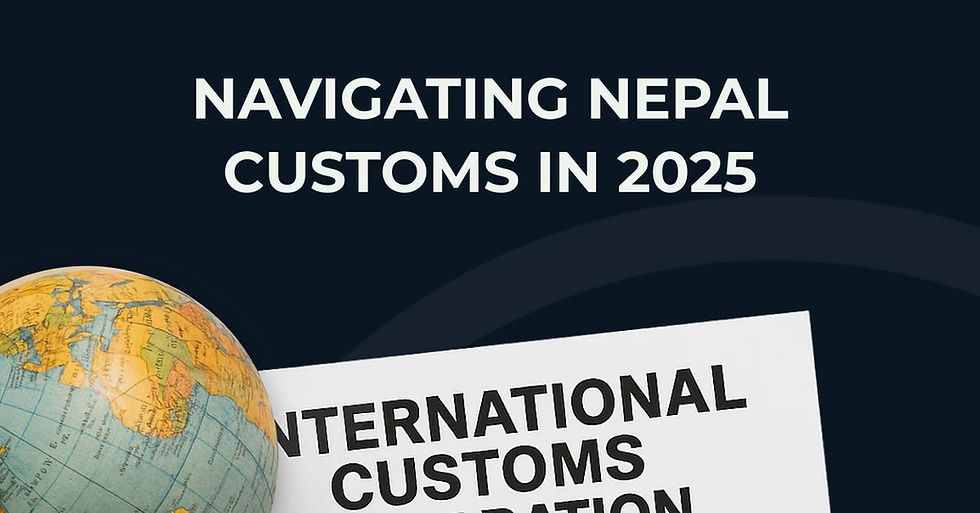What Is Cold‑Chain Logistics? A Comprehensive Guide for Nepal
- sudev968
- Aug 25
- 4 min read

Imagine a world without fresh dairy, vaccines, or imported seafood—food spoiling on the shelf, essential medicines losing potency, entire industries grinding to a halt. That’s the grim reality without reliable cold‑chain logistics.
Cold‑chain transport is the backbone of any temperature‑sensitive supply chain, ensuring products remain within strict temperature ranges from origin to destination. In Nepal—where geography, climate extremes, and infrastructure gaps pose unique challenges—building a robust cold chain & logistics network is essential for food security, healthcare, and trade growth.
This guide explains what cold‑chain logistics is, how it works, why it matters in Nepal, and the best practices to keep your products safe and compliant.
1. Defining Cold‑Chain Logistics
Cold‑chain logistics refers to the integrated system of:
Refrigerated storage (warehouses, cold rooms)
Temperature‑controlled transport (trucks, containers, air cargo)
Specialized packaging (insulation, gel packs, dry ice)
Monitoring systems (sensors, data loggers, IoT)
—all designed to preserve the quality and safety of perishable goods such as food, pharmaceuticals, and chemicals. Sometimes called cool chain logistics or simply cold logistics, this process controls temperature and humidity at every touchpoint.
2. Key Components of a Cold‑Chain Process
A successful cold‑chain process typically involves:
Pre‑Cooling & Conditioning• Rapidly lowering product temperature to target range.• Example: Pre‑cooling vegetables to 0–4 °C before loading.
Refrigerated Storage• Cold storage facilities maintain stable conditions (e.g., 2–8 °C or –18 °C).• Includes blast freezers, cold rooms, and freezer vaults.
Temperature‑Controlled Transport• Specialized refrigerated transport trucks, reefer containers, and air‑freight ULDs (unit load devices).• Known as cold‑chain transport or refrigerated logistics companies.
Packaging & Insulation• Insulated boxes, gel packs, or dry ice to buffer against temperature fluctuations.• Critical for “last‑mile” delivery where ambient conditions vary widely.
Real‑Time Monitoring & Traceability• IoT sensors and data loggers record temperature and humidity.• Cloud platforms trigger alerts if conditions deviate.
Compliance & Documentation• Adherence to GDP (Good Distribution Practice) for pharmaceuticals.• Food safety standards (HACCP, FSMS).
(See an example of a cold‑chain process infographic below.)
3. Why Cold‑Chain Matters in Nepal
3.1 Food Security & Quality
Fresh produce, dairy, meat, and seafood rely on cold storage logistics to retain nutrition and safety.
In Nepal’s mountainous terrain, quick spoilage is a major risk without a reliable “farm to fork” cold chain.
3.2 Healthcare & Vaccines
Vaccines and biologics lose potency if exposed to incorrect temperatures.
Nepal’s public health initiatives depend on strict pharmaceutical cold‑chain management to reach remote clinics safely.
3.3 Economic Growth & Trade
Exporters of fruits, flowers, and specialty crops need temperature‑controlled supply chains to access global markets.
A strong cold‑chain logistics network encourages agribusiness investment and boosts farmer incomes.
4. Cold‑Chain Logistics in Nepal: Challenges & Solutions
Challenge | Solution |
Geographic extremes (high altitude, remote villages) | Multi‑modal transport: truck → air → local refrigerated vehicles |
Seasonal power cuts impacting cold storage | Backup generators, solar‑powered refrigeration units |
Lack of standardized cold‑chain 3PL providers | Integrating with leading international freight forwarding |
Limited real‑time monitoring in transit | Deploying IoT sensors with GSM connectivity for remote areas |
High cost of specialized reefer equipment | Shared cold rooms and co‑storage models to optimize capacity |
Orient International Relocation partners with global refrigerated logistics companies to extend proven cold‑chain expertise into Nepal. Our solutions include blast freezing at origin, climate‑controlled cross‑border transport, and last‑mile refrigerated delivery in Kathmandu, Birgunj, and beyond.
5. How Cold‑Chain Transport Works: Step by Step
Collection & Conditioning• Harvest or produce is immediately cooled in blast freezers.
Primary Storage• Stored in temperature‑controlled warehouses until pickup.
Main‑Leg Transport• Loaded into reefer containers for trucking or air‑freight.• Continuous temperature logging via onboard data loggers.
Cross‑Border Clearance• Customs documentation verifying GDP or HACCP compliance.
Secondary Storage & Distribution• Unloaded into regional cold rooms.• Picked and packed into smaller insulated vehicles for local delivery.
Last‑Mile Delivery• Final refrigerated transport to retail outlets, clinics, or restaurants.
(For an annotated process infographic, see our Resources page.)
6. Use Cases & Industry Applications
Pharmaceuticals & Vaccines
Temperature range: 2–8 °C or –20 °C (for certain biologics)
Compliance with WHO cold‑chain protocols is non-negotiable.
Fresh Produce & Dairy
Temperature range: 0–4 °C
Traceability and speed preserve freshness and prevent spoilage.
Seafood & Meat Products
Temperature range: –18 °C to –20 °C
Requires deep‑freeze blast chilling and insulated packaging for long-haul routes.
Floral Logistics
Temperature range: 1–4 °C
Ethylene removal and humidity control extend vase life.
7. Choosing the Right Cold‑Chain Logistics Partner
When selecting a provider in Nepal, look for:
Comprehensive Services: End‑to‑end solutions from packing to last‑mile delivery.
ISO/GDP Compliance: Certifications ensuring quality standards.
Infrastructure Footprint: Network of cold rooms and refrigerated vehicles.
Real‑Time Monitoring: IoT‑enabled temperature tracking and alerting.
Local Expertise & Global Reach: Experience navigating Nepal’s terrain and cross-border regulations.
Orient International Relocation delivers all this via our International Freight Forwarding Services and on‑ground cold‑chain capabilities.
8. Cost Considerations & ROI
Cold‑chain logistics costs typically include:
Equipment rental or capital investment (reefers, cold rooms)
Energy and fuel consumption for refrigeration
Packaging materials (insulated boxes, gel packs, dry ice)
Monitoring systems subscription fees
Operational labor for handling and distribution
While initial outlay can be significant, the ROI manifests as:
Reduced spoilage and waste
Higher quality and safety compliance
Access to premium markets and pricing
Enhanced brand reputation for reliability and freshness
9. Future Trends in Cold‑Chain Logistics
Solar‑Powered Refrigeration: Off‑grid solutions for remote areas.
Blockchain Tracking: Immutable temperature logs for true transparency.
AI‑Driven Demand Forecasting: Optimizing inventory and minimizing waste.
Green Cold Chain: Environmentally friendly refrigerants and energy sources.
Orient is actively piloting solar‑hybrid cold rooms in remote Nepali districts, bringing sustainable cold chain transport closer to underserved communities.
10. Conclusion & Next Steps
Building a cold‑chain logistics network in Nepal is no small feat—but it’s critical for food security, public health, and economic growth. Whether you’re an agribusiness exporter, a pharmaceutical distributor, or a restaurant chain, reliable cold‑chain transport can make the difference between success and loss.
Ready to optimize your cold‑chain?
Explore our International Freight Forwarding Services
Get a personalized cold‑chain solutions quote via our Contact page
Learn more about our Relocation & Logistics offerings
With Orient International Relocation as your partner, you’ll gain the expertise, technology, and reliability needed to keep your temperature‑sensitive goods safe—from Kathmandu to the world.



Comments